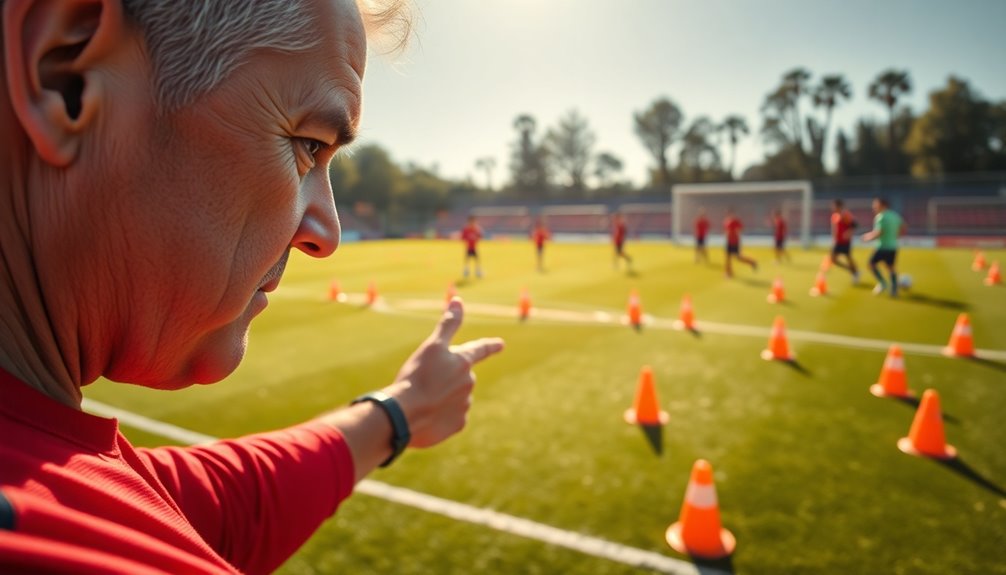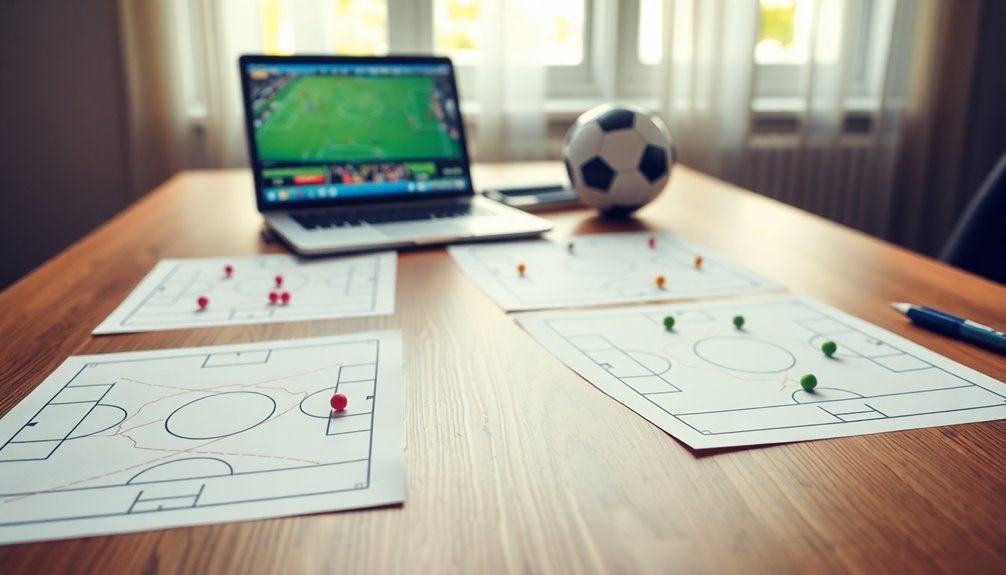
Breaking Down Soccer Diagrams for Better Strategy
February 7, 2025Breaking down soccer diagrams is essential for mastering strategies that boost your game. They simplify complex formations, making it easier for you to understand your role on the field. By analyzing key tactical models, like Tiki-Taka or counter-attacking plays, you can enhance your decision-making and positioning. Understanding spacing and effective passing patterns enables smoother communication and teamwork with your teammates. Diagrams also accommodate different learning styles, helping players of all ages grasp fundamental concepts. If you keep exploring, you'll uncover more techniques to elevate your soccer strategy and teamwork.
Understanding Soccer Diagrams
Understanding soccer diagrams is essential for grasping the game's strategies and formations. These visual tools break down complex soccer tactics into digestible parts, making it easier for you to comprehend player positioning and roles on the field.
When you look at a diagram, you'll often see common formations like 4-4-2, 3-5-2, or 4-3-3, each providing insights into how players should operate during a match. Diagrams typically include arrows that represent player movements, passing lanes, and pressing strategies. This helps you visualize dynamic game situations and anticipate the flow of play. For instance, formations like the 2-3-1 formation can illustrate how to effectively connect defense and attack. Understanding the roles of a goalkeeper is vital for interpreting how formations protect the goal.
By studying tactical diagrams, you can enhance your situational awareness, allowing you to make informed decisions during matches. Don't overlook how these diagrams can also illustrate set pieces, such as free kicks and corner plays. Understanding the arrangements shown in these tactical diagrams can optimize scoring opportunities and improve your team's overall performance. Ultimately, mastering soccer diagrams equips you with the knowledge to better understand the game, communicate effectively with teammates, and elevate your strategic thinking on the pitch. Additionally, recognizing the importance of adaptability in formations allows teams to adjust their strategies based on the opponent's strengths and weaknesses.
Key Tactical Models
In this section, you'll explore key tactical models that can elevate your game.
We'll break down the principles of Tiki-Taka, the strategies behind effective counter-attacking, and the defensive techniques of Catenaccio. Understanding these models will help you make smarter decisions on the pitch. Additionally, having a solid grasp of defensive responsibilities allows teams to effectively implement these tactical strategies during matches. A comprehensive understanding of defensive positioning enhances a team's ability to execute these tactics successfully, while a well-defined formation selection can significantly influence the effectiveness of these strategies.
Tiki-Taka Principles Explained
Tiki-Taka revolutionizes the way teams approach possession-based football, focusing on short, precise passes to dismantle defensive setups. This style, famously employed by FC Barcelona and the Spanish national team, emphasizes keeping the ball for extended periods, often controlling 60-70% of possession.
As a player, mastering quick ball movement is vital; it demands exceptional technical skills, including ball control, vision, and teamwork.
In Tiki-Taka, you'll notice that players interchange positions fluidly, creating confusion among defenders and maintaining constant movement. This dynamic play allows your team to dictate the game's tempo while applying sustained pressure on the opposition.
Understanding spatial awareness is significant, as it enables you to make quick decisions under pressure, facilitating intricate passing patterns that lead to scoring opportunities.
The effectiveness of Tiki-Taka lies in its simplicity and precision. Each player must be committed to maintaining possession and supporting teammates, ensuring that the ball circulates effectively.
Counter-Attacking Strategies Overview
Counter-attacking strategies are essential for teams looking to exploit their opponents' vulnerabilities during a match. This approach involves a quick shift from defense to offense, often utilizing swift and skillful attackers. By dropping deep and inviting the opposition to commit players forward, your team can create valuable space for rapid counter-attacking opportunities.
Successful counter-attacks rely on precise passing and movement. You'll need players who can make quick decisions to capitalize on the opponent's disorganization. A well-executed counter-attack can turn the tide of a game, as seen with Leicester City in the 2015/16 season and Real Madrid in 2014, both of whom secured significant victories through effective counter-attacking tactics.
To enhance your team's counter-attacking effectiveness, incorporate drills that focus on fast ball recovery, decisive passing under pressure, and creating overloads in attacking zones.
This strategy can be particularly effective against teams that employ a pressing game, as it allows you to exploit the gaps left when they push forward. By mastering these elements of counter-attacking, you'll be better prepared to dominate your opponents and seize victory.
Catenaccio Defensive Techniques
Catenaccio defensive techniques offer a robust framework for teams aiming to establish a solid defensive foundation. This model emphasizes defensive stability through a tightly packed defensive line, limiting your opponent's space to maneuver.
By employing a sweeper, or libero, you can enhance your team's defensive shape while preparing for quick counter-attacks when you regain possession.
To effectively implement the Catenaccio strategy, focus on these key elements:
- Tactical Awareness: Guarantee your players understand their roles and responsibilities in maintaining tight formations.
- Positioning: Keep your players organized, minimizing gaps that attackers can exploit.
- Well-Timed Tackles: Encourage disciplined defending to disrupt the opponent's flow and regain possession efficiently.
- Frustration Tactics: Aim to deny clear scoring opportunities, particularly against strong attacking teams.
Analyzing Field Positioning

When analyzing field positioning, understanding spacing is indispensable, especially for younger players. For those aged U6-U7, maintaining a distance of 5-8 yards is essential for effective passing and receiving. Additionally, maintaining proper compactness in positioning allows players to limit the opponent's passing options and enhance defensive coverage. Consistent practice of agility drills helps young players develop the quickness needed to adjust their positioning effectively.
As players progress to U13-U16, you'll want to increase that spacing to 16-30 yards. This adjustment opens up greater tactical options and minimizes the chances of defenders intercepting passes. Good spacing is critical in preventing a single defender from covering multiple attackers. This not only enhances your attacking opportunities but also creates the necessary space for effective plays.
By introducing spacing concepts early, you're helping players refine their skills and preparing them for more complex game situations as they advance. Furthermore, effective field positioning involves being aware of the opponent's positioning. This awareness allows you to exploit gaps and make strategic plays based on the dynamics of the game. Moreover, understanding footwork drills can significantly improve a player's ability to maintain proper positioning while receiving passes.
Passing Patterns Explained
One of the keys to effective soccer play lies in mastering passing patterns, which are essential for keeping possession and creating scoring chances.
By understanding and implementing these patterns, you can promote fluid movement among your teammates and strategically position yourselves on the field.
Here are four important elements to contemplate:
- Check Out Wide: Move to the flanks to create angles for receiving the ball, enhancing your distribution options. This tactic can also aid in maintaining close ball control when transitioning from defense to attack. The use of overlapping runs can further stretch the defense, creating additional passing lanes.
- Body Positioning: Before receiving, focus on your body stance and perform shoulder checks to stay aware of the field and your teammates.
- Overlap and Underlap: Utilize these movements within your passing patterns to confuse defenders and create space for attacking players.
- Diagonal Passes: Make diagonal passes to exploit gaps in the opponent's defense, allowing your team to progress the ball forward effectively.
Additionally, understanding the role of attacking midfielders can significantly enhance your passing dynamics and overall team strategy.
Importance of Spacing

Spacing is vital for effective passing and enhances your offensive options on the field.
When you understand the right passing distances, you can make better decisions and avoid pressure from defenders. Additionally, understanding how midfielders act as passing outlets can further improve your ability to create and exploit space on the field. The success of your offensive plays often relies on the collaboration among all players on the field, especially the 11 players on each team.
Plus, focusing on spacing early in training helps you develop essential skills that will benefit the whole team as the game gets more complex. Additionally, mastering defensive stance drills can further improve your ability to create and exploit space on the field.
Effective Passing Distances
Effective passing distances are essential for maintaining the flow of play in soccer. Proper spacing allows you to receive passes before facing opponent pressure, which enhances ball retention and opens up offensive options.
By understanding effective passing distances, you can improve your game considerably. Here are some key points to take into account:
- Youth Players (U6-U7): Maintain spacing of 5-8 yards to guarantee effective play.
- Older Youth (U16-U18): Increase your passing distances to 16-36 yards for ideal performance.
- Defensive Strategy: Good spacing prevents a single defender from covering multiple attackers, increasing your offensive options.
- Skill Development: Introducing spacing concepts early helps refine skills as players shift to complex game scenarios.
Offensive Options Enhancement
Maintaining the right distance on the field not only facilitates effective passing but also considerably enhances your offensive options. Proper spacing concepts allow you to receive passes with time to make decisions, reducing the pressure from defenders.
For younger players, keeping passing distances around 5-8 yards is essential, while older players should aim for 16-36 yards. As an attacking team, good spacing means that a single defender can't effectively cover multiple attackers, creating more opportunities for scoring.
When you implement effective spacing, it's easier to find open teammates and exploit gaps in the defense. Additionally, clear communication about positioning helps everyone on the team make better decisions, ultimately improving your overall offensive plays.
As you refine your skills, understanding the importance of maintaining distance from both teammates and opponents becomes significant.
Early Skill Development
As young players develop their skills, understanding the importance of proper spacing becomes essential for their growth on the field.
Introducing spacing concepts early helps young athletes refine their abilities and enhances their decision-making during games.
Here are four key benefits of focusing on spacing:
- Effective Pass Reception: Proper spacing allows players to receive passes easily, especially for U6-U7 (5-8 yards) and U11-U12 (16-20 yards) age groups.
- Creating Passing Lanes: Good spacing creates clear passing lanes, making it easier to connect with teammates and avoid defenders.
- Enhanced Team Cohesion: When players learn to position themselves effectively, the team plays more cohesively, allowing for better support and strategic movement.
- Improved Offensive Options: Spacing prevents defenders from covering multiple attackers, increasing the chances of successful passes and scoring opportunities.
Drill Examples for Coaches
Drills play an essential role in shaping a team's strategy and skill set. One effective drill you can implement is the "Build Up from the Back" exercise. This drill emphasizes passing patterns and angles, helping players maintain possession while shifting from defense to attack. Start by having your goalkeeper play the ball into an attacking player, allowing them to practice turning and dribbling under pressure.
To simulate realistic game scenarios, incorporate 1v1 situations with dummies representing defenders. This helps players develop their skills in maneuvering tight spaces and making quick decisions. Encourage your players to utilize overlapping and underlapping runs during the build-up play, creating passing options that enhance tactical fluidity.
It's also important to establish a common terminology for your drills. For instance, using terms like "fire lane" for movement away from defenders fosters better understanding and communication among players.
Enhancing Team Communication

Effective communication on the field can make all the difference in executing your team's tactical strategies. When players understand their roles and responsibilities clearly, it fosters teamwork and enhances performance.
Here are some effective ways to improve communication:
- Consistent Phrases: Use specific terms like "flip your hips" during practice to reinforce key concepts. This helps everyone stay on the same page.
- Structured Drills: Implement communication drills where players call out passing options or defensive responsibilities. This encourages quick, informed decisions.
- Feedback Sessions: Regularly hold feedback discussions between coaches and players. This helps refine communication skills and allows for adaptations during games.
- Shared Tactical Language: Establish a common vocabulary among players. This enables instantaneous adjustments and smooth execution of strategies, especially under pressure.
Visual Learning in Soccer
Visual aids play an essential role in enhancing players' understanding of tactical strategies in soccer. By using diagrams, you simplify complex formations and movement concepts, making it easier for you and your teammates to grasp your roles on the field.
When you incorporate visual learning into training sessions, it fosters discussions about player roles and responsibilities, which boosts communication and teamwork.
Research shows that players who engage with visual aids, like tactical boards and video analysis, tend to make better decisions during matches. This improvement comes from heightened situational awareness, allowing you to react more effectively to game dynamics.
Soccer diagrams can clearly illustrate various formations and tactical strategies, enabling coaches to convey their game plans to players of all ages and skill levels.
Moreover, incorporating these visual learning tools caters to different learning styles, especially helping those who may struggle with traditional verbal instructions.
By embracing visual learning, you can enhance your understanding of tactical strategies and improve overall performance on the pitch.
Conclusion
As you dive deeper into soccer diagrams, you'll reveal strategies that could transform your game. Imagine the thrill of executing a perfectly timed pass or outsmarting your opponent with clever positioning. These insights don't just improve your understanding; they elevate your entire team's performance. So, are you ready to take your tactics to the next level? The field awaits, and every diagram holds the key to releasing a new victory. Don't let the chance slip away!


